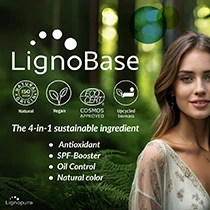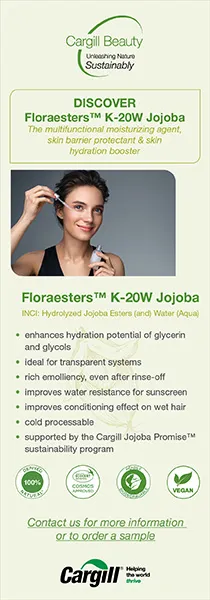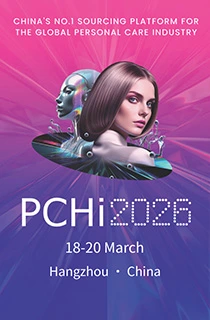Antioxidant shampoo and skin care formulations for photoprotection, antipollution and scalp eubiosis

04 Oct 2023 --- This report covers the latest advancements in personal care science, on two shampoo formulations and two topical antioxidant formulas. The developments include a solid shampoo that upcycles mango peel extract, alongside a study examining the effects of certain shampoos on the scalp’s prokaryotic and eukaryotic microbiota composition.
In further research, Personal Care Insights presents the findings of a triple antioxidant formula that is studied for its antipollution properties, alongside the efficacy of stronger and newer forms of vitamin C.
Combating “excessive” waste
With aims to mitigate the excessive use of water and plastic packaging, as well as food waste, researchers writing in the journal MDPI have developed a solid shampoo using upcycled mango peels as a source of antioxidants.
“Currently, between two and three billion people face water scarcity for at least one month per year. Water scarcity has severe consequences, including negative impacts on human and ecosystem health, restrictions on industrial and agricultural production and a wide range of social, economic and political disruptions,” write the authors.
“Therefore, industries need to adopt cleaner production technologies to save this natural resource. In most cosmetic products, the amount of water accounts for more than 65% of the total formula volume. For instance, a usual cream contains 60 to 80% water, and a shampoo up to 95%.”
They conclude that the mango peel is a “strong” source of antioxidants and can potentially “replace commercial antioxidants in cosmetics.”(Image credits: Mango peel extract study).
They highlight that food by-products are often rich in phenolic compounds characterized by antioxidant, anti-inflammatory and antibacterial properties.
“Since mango is the second most produced tropical fruit worldwide, leading to the generation of around 20 to 30 million tonnes of peels and seeds every year, globally, it is relevant when studying the possibility of reusing this waste,” continue the authors.
Rich phenolic compounds
The researchers extracted essential oil from an orange peel for natural fragrance while extracting phenolic compounds from the mango peel to create six samples of solid shampoos.
Different extraction methods resulted in differing phenolic compounds. Some include gallic acid, chlorogenic acid, catechin kaempferol, quercetin, mangiferin, chlorogenic acid and caffeic acid.
“Formulations containing mango peel extract exhibited higher capacity in inhibiting the DPPH and ABTS radicals compared to the formulations containing commercial antioxidants throughout the study period,” underscore the authors.
The mango peel extract did not affect pH value, surface tension, dirt dispersion and the thermal stability of the shampoo. It also did not damage the hair.
Despite the positive results, the researchers flag that future studies should include toxicity assays of mango peel extract due to possible traces of pesticides or fertilizers.
Microbiome-friendly shampoos
In a separate study by Henkel and Furtwangen University, researchers investigated two commercially available shampoo formulations’ effects on the scalp microbiome. The formula of two commercially available shampoos tested (Image credits: Henkel study).
Over the two-week testing period, they found no “qualitative changes in the scalp microbial community structure,” instead, they found preserving or stimulating effects of the shampoo. However, they suggest further research be carried out to see long-term results.
“So far, the use of shampoo has not been regarded as a major factor in determining human scalp microbiota composition,” write the authors.
The study tested two shampoos on two cohorts of 25 people with straight hair who were told not to color their hair one week before testing nor wash or cosmetically treat their hair 24 hours before sampling.
“P1 [product formula in the table], in particular, showed a statistically significant increase in cultivable bacteria and fungi. In contrast, product P2 [product formula in the table] only showed a significant change in the fungal numbers, while the bacterial numbers remained unaffected,” share the authors.
“The shampoo formulations largely positively influenced scalp germ counts, suggesting a ‘microbiome-friendly’ character of the investigated formulations.”
Oxidative stress by air pollution
Further research by New York University and Mary Kay find that combining three antioxidants decreases the harmful impacts of rural particulate pollution in human keratinocytes (primary cell type in the epidermis).
Industrialized urban areas cause air pollution and affect rural areas with particulate matter (PM) due to air circulation. Previous research has found that exposure to air pollution is associated with skin aging, such as wrinkles and spot formation.
“There is sufficient evidence to establish that PM2.5 penetrates skin cells and has a major role in the impact of air pollution on human health and is closely associated with PM-induced skin disease,” flag the authors.
PM can trigger oxidative stress, leading to cytotoxic skin responses, according to the researchers. Therefore, they tested whether the three combined antioxidants (AOx) counteract such pathways involved in PM2.5 exposure.
The three components were 0.1 mM resveratrol and 1.6 mM niacinamide from Sigma-Aldrich and 3 mM GHK (glycyl- L- histidyl- L-lysine) from Lucas Meyer Cosmetics. These have been extensively researched for their oxidative, stress and inflammation-fighting properties.
“For example, resveratrol has been shown to inhibit the PM-induced inflammatory response in human keratinocytes. GHK has been shown to modulate skin repair processes, and niacinamide has been shown to reduce the pro-inflammatory response of keratinocytes to both UVR and PM2.5,” detail the authors.
The study outlines that pretreatment of keratinocytes with the AOx formulation “significantly reduced the generation of reactive oxygen species by PM2.5.” RNA-sequencing showed that AOx inhibited the expression of significant enzymes and protected cells from the potentially harmful effects of metabolizing PM2.5.
“Together, these data suggest antioxidant intervention may protect keratinocytes from PM2.5-induced…inflammation and carcinogenesis,” detail the authors.
Skin protecting serum
A separate study on Asta C Vitamin C Age Defense Serum by Dr. Whitney Bowe Beauty — which features vitamin C, astaxanthin and fermented turmeric — finds that it is “safe, well-tolerated and improves skin quality, such as wrinkles, radiance and hyperpigmentation.”Improvements in hyperpigmentation after 12 weeks (Image credits: Asta C study).
Application of Asta C twice a day was tested over 12 weeks on 32 subjects. The serum aims to provide antioxidants to neutralize reactive oxygen species that damage skin cell DNA, proteins and lipids.
“In addition to acting as an antioxidant that both neutralizes and reduces the formation of reactive oxygen species, vitamin C is a required cofactor in the collagen synthesis pathway and has a role in the signaling cascade for fibroblast proliferation,” write the authors.
Enhancing the antioxidants
However, L-ascorbic acid derivatives pose a challenge in formulations as they oxidize quickly.
“One vitamin C derivative quickly gaining popularity is tetrahexyldecyl ascorbate (THD ascorbate)....THD ascorbate is converted to L-ascorbic acid through enzymes in the skin, and this derivative of vitamin C is oil-soluble, unlike water-soluble L-ascorbic acid,” detail the authors.
The researchers spotlight 3-O- Ethyl ascorbic acid as another derivative of L-ascorbic acid, which is water-soluble and structurally similar to L-ascorbic acid, however, the addition of “an ethyl group provides enhanced stability to the molecule.”
“Therefore, combining water-soluble and oil-soluble formulations, such as THD ascorbate and 3-O-Ethyl ascorbic acid, creates an ideal solution that works in a complementary fashion to deeply penetrate and permeate through the skin,” they continue.
Furthermore, as turmeric is known for its antioxidants, the researchers fermented turmeric with lactobacilli to increase the concentration of curcumin without increasing its cytotoxicity.
Lastly, they highlight that astaxanthin has more reactive oxygen species scavenging capacity than vitamin C or E, providing photoprotective and anti-inflammatory benefits.
By Venya Patel












